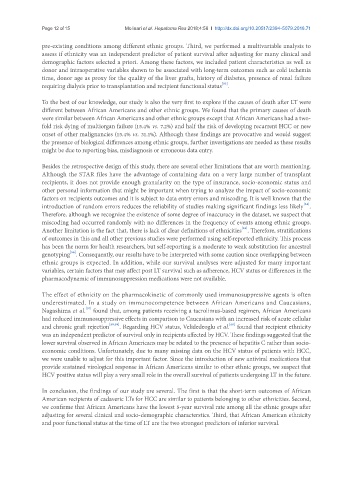Page 203 - Read Online
P. 203
Page 12 of 15 Molinari et al. Hepatoma Res 2018;4:56 I http://dx.doi.org/10.20517/2394-5079.2018.71
pre-existing conditions among different ethnic groups. Third, we performed a multivariable analysis to
assess if ethnicity was an independent predictor of patient survival after adjusting for many clinical and
demographic factors selected a priori. Among these factors, we included patient characteristics as well as
donor and intraoperative variables shown to be associated with long-term outcomes such as cold ischemia
time, donor age as proxy for the quality of the liver grafts, history of diabetes, presence of renal failure
[53]
requiring dialysis prior to transplantation and recipient functional status .
To the best of our knowledge, our study is also the very first to explore if the causes of death after LT were
different between African Americans and other ethnic groups. We found that the primary causes of death
were similar between African Americans and other ethnic groups except that African Americans had a two-
fold risk dying of multiorgan failure (15.4% vs. 7.2%) and half the risk of developing recurrent HCC or new
onset of other malignancies (15.4% vs. 31.1%). Although these findings are provocative and would suggest
the presence of biological differences among ethnic groups, further investigations are needed as these results
might be due to reporting bias, misdiagnosis or erroneous data entry.
Besides the retrospective design of this study, there are several other limitations that are worth mentioning.
Although the STAR files have the advantage of containing data on a very large number of transplant
recipients, it does not provide enough granularity on the type of insurance, socio-economic status and
other personal information that might be important when trying to analyze the impact of socio-economic
factors on recipients outcomes and it is subject to data entry errors and miscoding. It is well known that the
[54]
introduction of random errors reduces the reliability of studies making significant findings less likely .
Therefore, although we recognize the existence of some degree of inaccuracy in the dataset, we suspect that
miscoding had occurred randomly with no differences in the frequency of events among ethnic groups.
[55]
Another limitation is the fact that, there is lack of clear definitions of ethnicities . Therefore, stratifications
of outcomes in this and all other previous studies were performed using self-reported ethnicity. This process
has been the norm for health researchers, but self-reporting is a moderate to weak substitution for ancestral
[56]
genotyping . Consequently, our results have to be interpreted with some caution since overlapping between
ethnic groups is expected. In addition, while our survival analyses were adjusted for many important
variables, certain factors that may affect post LT survival such as adherence, HCV status or differences in the
pharmacodynamic of immunosuppression medications were not available.
The effect of ethnicity on the pharmacokinetic of commonly used immunosuppressive agents is often
underestimated. In a study on immunocompetence between African Americans and Caucasians,
[57]
Nagashima et al. found that, among patients receiving a tacrolimus-based regimen, African Americans
had reduced immunosuppressive effects in comparison to Caucasians with an increased risk of acute cellular
[60]
and chronic graft rejection [58,59] . Regarding HCV status, Velidedeoglu et al. found that recipient ethnicity
was an independent predictor of survival only in recipients affected by HCV. These findings suggested that the
lower survival observed in African Americans may be related to the presence of hepatitis C rather than socio-
economic conditions. Unfortunately, due to many missing data on the HCV status of patients with HCC,
we were unable to adjust for this important factor. Since the introduction of new antiviral medications that
provide sustained virological response in African Americans similar to other ethnic groups, we suspect that
HCV positive status will play a very small role in the overall survival of patients undergoing LT in the future.
In conclusion, the findings of our study are several. The first is that the short-term outcomes of African
American recipients of cadaveric LTs for HCC are similar to patients belonging to other ethnicities. Second,
we confirme that African Americans have the lowest 5-year survival rate among all the ethnic groups after
adjusting for several clinical and socio-demographic characterstics. Third, that African American ethnicity
and poor functional status at the time of LT are the two strongest predictors of inferior survival.

